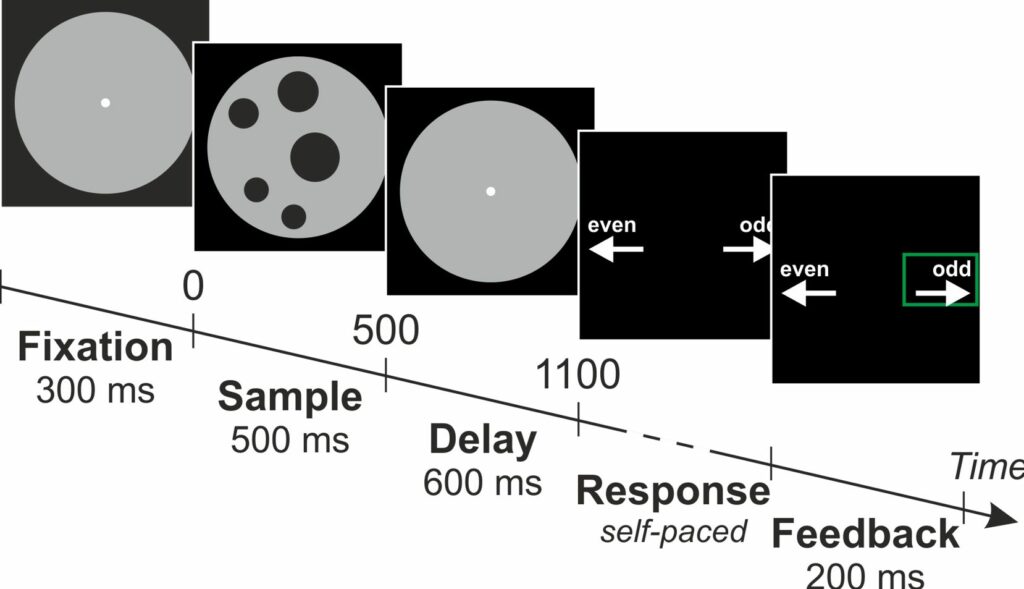Why We Can Instantly Recognize Small Numbers but Struggle with Large Ones? New Insights Into How Our Brain Handles Small Vs. Large Numbers
Our brain’s nerve cells have a knack for small numbers, according to a groundbreaking Tübingen and Bonn study.
An investigation carried out by Tubingen and Bonn came to the conclusion that there are two distinct processing mechanisms.
When two, three, or four apples are in front of us, we can quickly tell how many apples there are. However, we take a lot longer and often estimate incorrectly if there are five or more apples. Actually, the brain does distinguish between smaller and greater quantities of items differently.
This was shown in recent research conducted by the Universities of Tübingen, Bonn, and University Hospital Bonn. The Nature Human Behaviour journal reported the findings.
Assume someone gives us a snapshot of a string quartet and asks us to guess how many members are in the photograph. There isn’t enough time to count them all, but we can all respond quickly: “Four!” The next image depicts a septet, but we are again only given a moment to examine it. This time, we pause and are not nearly as sure: “Eight.” In reality, the right answer is 7, although we came extremely close.
We as humans appear to process a variety of facts in one of two unique ways: Usually, we can accurately and rapidly notice a limited number of items. This is also known as “subitizing” in academic circles. But when there are five or more parts, this method changes quickly: We take a growing amount of time to respond, and the precision of our responses also increases.
As a result, some researchers theorized that the brain had two distinct processing strategies: one that is exact for small numbers and one that uses an estimating mechanism for higher numbers of objects.
“However, this idea has been disputed up to now,” comments Prof. Florian Mormann from the Department of Epileptology at the University Hospital Bonn. “It could also be that our brain always makes an estimate but the error rates for smaller numbers of things are so low that they simply go unnoticed.”
The neurons that process fewer things are more specialized
The new study, on the other hand, shows that we do in fact handle small and big amounts of things differently.
The project’s research teams were able to show a few years ago that the brain had nerve cells that are accountable for each number. For instance, some neurons typically fire for two elements, others for four elements, and still other neurons primarily fire for seven elements.

“However, the neurons also fire in response to slight variations in the number,” adds main author Prof. Andreas Nieder from the University of Tübingen. “A brain cell for a number of “seven” elements thus also fires for six and eight elements but more weakly. The same cell is still activated but even less so for five or nine elements.”
This “numerical distance effect” has previously been shown by Nieder in tests on monkeys. It’s interesting to note that this impact only seems to manifest in bigger numbers in humans. The neurobiologist claims that there “seems to be an additional mechanism for numbers of around less than five elements that makes these neurons more precise.”
When a brain cell associated with the number three fires, it suppresses neighboring cells associated with the numbers two and four. This lessens the possibility that these cells may also accidentally fire for the third number. The neurons that are engaged for the numbers 5, 6, and 8 do not, however, function according to this principle. This explains why the inaccuracy rate for these values is greater.
Watching each brain cell in action
The University Hospital Bonn’s Department of Epileptology, which focuses on brain surgery, was an asset to the researchers doing the study.
There, surgeons perform procedures to remove the damaged nerve tissue in an effort to cure epilepsy. Sometimes electrodes are initially inserted into the brain of the patient in order to locate the epileptogenic center.
The study involved the participation of seventeen patients. As part of their pre-operative preparations, microelectrodes, as delicate as human hairs, were surgically inserted into their temporal lobes. Esther Kutter, who conducted a significant portion of the experiments for her doctoral research within Prof. Mormann’s research group, explains that these microelectrodes allowed researchers to monitor the responses of individual nerve cells to visual stimuli.

During the experiments, the test subjects were seated in front of a computer screen displaying various numbers of dots for just half a second. They were tasked with determining whether they had observed an even or odd number of dots. Astonishingly, the participants displayed remarkable swiftness and accuracy in their responses, particularly for quantities up to four dots. However, beyond this threshold, the number of errors increased, and the time required for decision-making grew.
These findings hold the promise of providing fresh insights into the mechanisms by which the human brain processes numerical information. In the long term, this research could contribute to a deeper understanding of dyscalculia, a developmental disorder characterized by difficulties in grasping numerical concepts.
Source: 10.1038/s41562-023-01709-3
Image Credit: Getty
